To introduce your baby to purees, watch for signs they’re ready, like sitting up and showing interest in food. Start with simple, single-ingredient purees from fruits or vegetables, blending until smooth. Cook foods thoroughly, then blend with water or breast milk to get a silky consistency. Introduce flavors gradually and observe for any reactions. Store leftovers safely, serve at appropriate temperatures, and as your baby progresses, you’ll learn how to adjust textures to support their development.
Key Takeaways
- Recognize signs of readiness, such as sitting unsupported and showing interest in food, before introducing purees.
- Start with single-ingredient, smooth purees made from fresh fruits or vegetables, blending until silky.
- Use gentle cooking methods like steaming or boiling to soften foods, then blend to desired consistency.
- Introduce new flavors gradually over several days, monitoring for allergies or adverse reactions.
- Store purees in labeled, airtight containers or ice trays, and discard leftovers left out over two hours for safety.
Understanding When Your Baby Is Ready for Solids
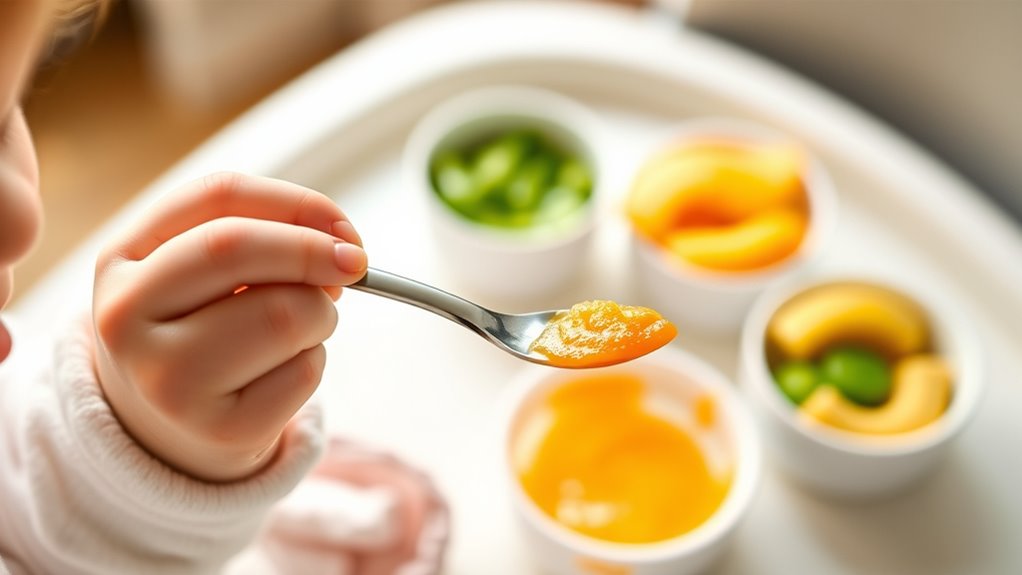
You’ll know your baby is ready for solids when they can sit up well with minimal support, show interest in your food, and have good head and neck control. These are key developmental milestones that signal they’re prepared for the next stage of eating. Watch for feeding cues such as leaning forward, opening their mouth, or reaching out for food. When your baby displays these signs, it shows they’re curious and prepared to explore new textures. Recognizing these indicators early helps ensure safe and timely introduction of solids. Proper timing ensures their developmental milestones align with their ability to handle new foods, making the transition smoother and more enjoyable. Additionally, understanding their emotional and spiritual states, as reflected in their reactions to new experiences, can support a positive feeding journey. Being attentive to their emotional responses can foster a sense of security and trust during this new phase. Moreover, paying attention to their developmental readiness can help tailor the introduction process to suit their individual pace.
Selecting the Perfect First Foods
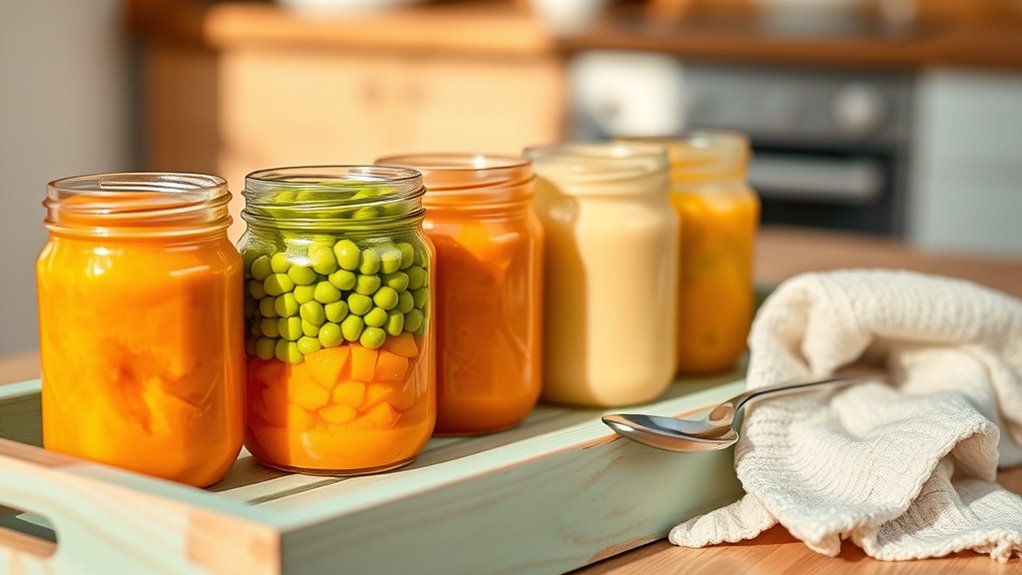
Choosing the right first foods sets the foundation for your baby’s eating habits and helps them develop a positive relationship with solids. Start with single-ingredient options like mashed fruits, vegetables, or iron-fortified cereals, which support their nutritional needs. Incorporating breastfeeding benefits, these initial foods complement breast milk and introduce new flavors gently. Keep in mind, introducing familiar, easily digestible foods can also positively affect baby sleep routines, making bedtime calmer and more predictable. Avoid foods that are highly allergenic or hard to swallow at this stage. Remember, patience is key—your baby may take time to accept new tastes. By selecting wholesome, simple foods early on, you foster healthy eating habits and create a supportive environment for their growth and development. For a well-rounded approach, consider exploring best anime movies that can inspire and entertain parents during meal prep or quiet time. Additionally, understanding the horsepower of electric dirt bikes can be useful if you’re considering outdoor activities that involve physical effort and energy.
Preparing and Cooking Puree Ingredients

Once you’ve selected wholesome, single-ingredient foods, preparing them properly guarantees they’re safe and easy for your baby to eat. Use appropriate cooking techniques like steaming, boiling, or baking to soften ingredients without losing nutrients. Steaming preserves more vitamins and keeps the texture gentle for your baby. When a recipe calls for a specific ingredient, consider ingredient substitutions if needed—such as sweet potatoes instead of carrots or applesauce instead of fresh apples—ensuring your options stay nutritious. Always peel, remove seeds, and cut foods into manageable pieces before cooking. Proper preparation minimizes choking hazards and simplifies blending later on. Additionally, understanding how to self water your plants can serve as a helpful analogy for maintaining just the right moisture levels in your baby’s purees. Paying attention to food safety guidelines and proper handling also helps prevent contamination and spoilage. Being aware of cookie categories helps you choose the right settings when managing your preferences for a safer and more tailored experience. By paying attention to cooking methods and ingredient swaps, you set a solid foundation for smooth, safe purees your little one will enjoy.
Blending and Achieving the Ideal Texture
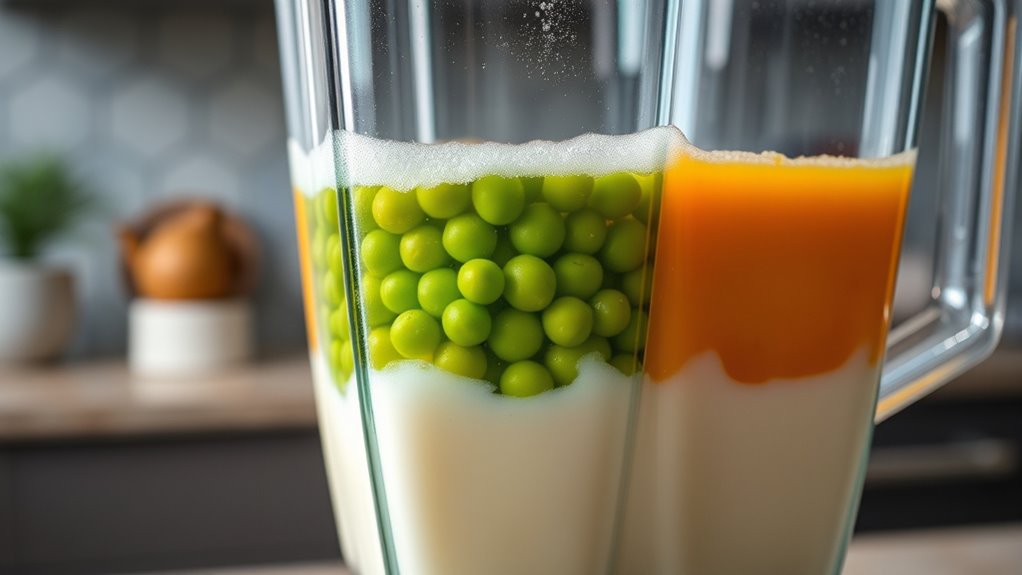
Achieving the perfect puree texture is essential for your baby’s safety and enjoyment. Proper texture development guarantees your little one can swallow comfortably and reduces choking risks. Start by blending cooked ingredients using simple techniques, such as puréeing until smooth. If the mixture is too thick, add small amounts of water, breast milk, or formula to loosen it. Gradually adjust the consistency based on your baby’s age and ability, aiming for a smooth, lump-free texture initially. As your baby develops, you can introduce slightly thicker blends. Use a blender or food processor to control the blending process, ensuring uniform consistency. Keep in mind that consistency is key—too runny or too thick can make feeding difficult or unsafe. Regularly check the texture to meet your baby’s evolving needs.
Introducing New Flavors and Monitoring Reactions
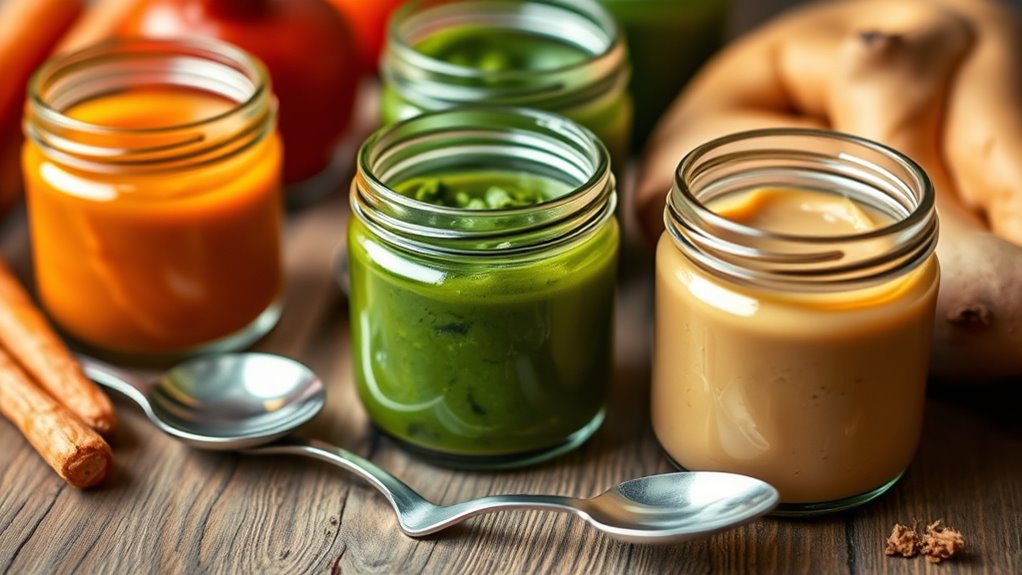
When introducing new flavors, do so gradually to see how your baby responds. Keep a close eye for any allergic signs like rashes, swelling, or difficulty breathing. Taking it slow helps you identify reactions early and guarantees a safe, enjoyable tasting experience. Being aware of signs and symptoms of an allergic reaction can further ensure your baby’s health and safety during the process. Additionally, understanding AI developments in healthcare might influence future dietary and allergy testing methods.
Watch for Allergic Signs
As you introduce new purees, monitoring for allergic signs is essential, since reactions can happen quickly and vary from mild to severe. Be attentive to any changes in your baby’s behavior or physical responses. Signs to watch include hives, swelling of the face or lips, difficulty breathing, vomiting, or diarrhea. Even if reactions seem minor, don’t dismiss them; they could escalate. Keep calm and observe closely during and after feeding. It’s helpful to keep a record of new foods and any reactions to identify potential allergens. If you notice any allergic reactions, stop giving that food immediately and consult your pediatrician. Early detection of allergic responses helps ensure your baby’s safety and guides safer feeding habits moving forward.
2. Add New Flavors Gradually
Introducing new flavors gradually is key to guaranteeing your baby’s safety and enjoyment. This approach helps you monitor reactions and build their palate confidently. When trying flavor combinations, start with simple pairings like apple and pear or carrot and sweet potato. Avoid overwhelming your baby with complex mixes initially. As you introduce new flavors, consider spice additions like a pinch of cinnamon or mild herbs to enhance taste without overpowering. Keep these tips in mind:
- Introduce one new flavor at a time, waiting 3-5 days before trying another.
- Observe your baby for any allergic signs or digestive issues.
- Mix familiar purees with small amounts of new flavors to ease acceptance.
- Gradually experiment with spice additions to diversify taste without causing discomfort.
Patience ensures your baby develops a healthy, adventurous palate safely.
Serving Purees Safely and Conveniently

To serve purees safely and conveniently, it’s important to follow proper handling and storage practices. Establish a consistent feeding schedule to help your baby develop routine and ensure they consume fresh, safe food. Always wash your hands thoroughly before preparing or serving purees to maintain baby food safety. Use clean utensils and containers to prevent contamination. When offering purees, check the temperature to avoid burns or discomfort—test a small amount first. Serve only the amount your baby can eat in one sitting to minimize waste and reduce the risk of spoilage. Keep leftovers refrigerated promptly and discard any leftover purees that have been out for over two hours. By following these steps, you ensure your baby enjoys nutritious, safe, and convenient meals.
Storing and Reusing Baby Food Purees
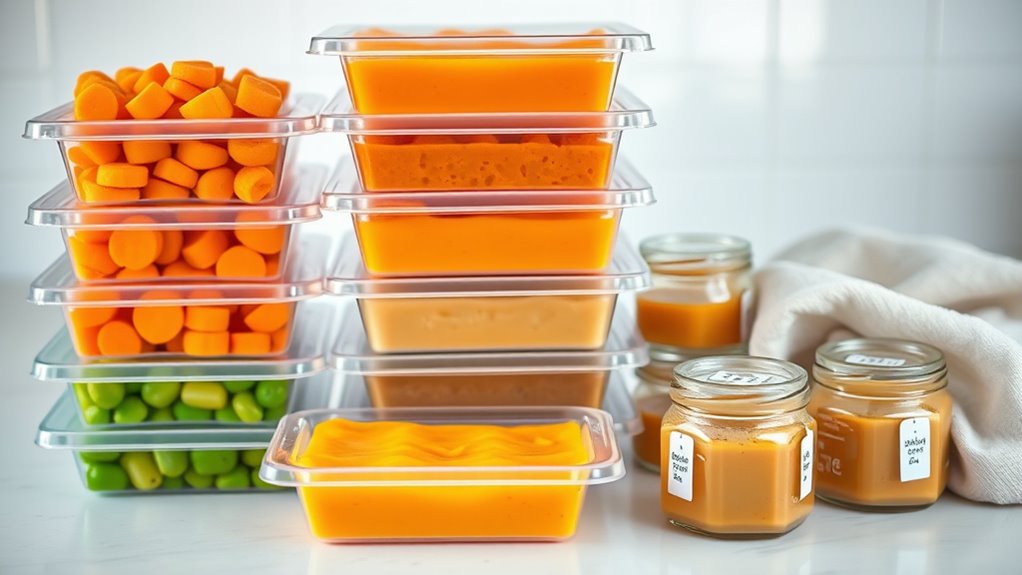
Storing and reusing baby food purees properly helps guarantee they stay safe and retain their nutritional value. Proper food storage is essential to prevent spoilage and contamination. Here are some reuse techniques to contemplate:
- Use airtight containers to minimize exposure to air and bacteria.
- Label each container with the date to ensure freshness.
- Freeze purees in small portions, like ice cube trays, for easy thawing.
- Thaw only what you’ll use, avoiding refreezing leftovers to maintain quality.
Tips for Making the Transition to More Textured Foods
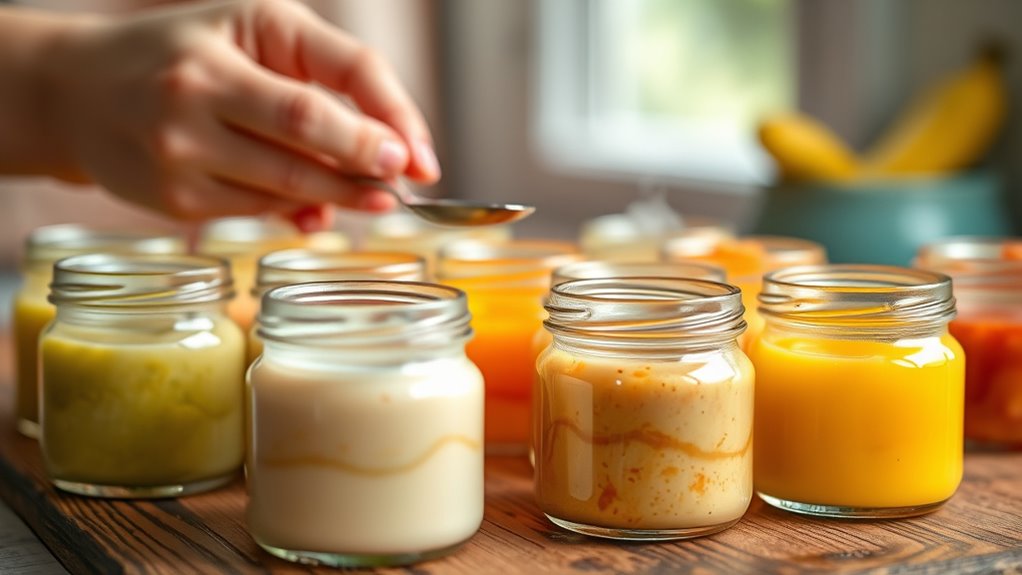
Once your baby has become comfortable with smooth purees, it’s time to gradually add more texture to their meals. Focus on the texture progression, observing their cues for baby readiness. Start by offering slightly chunkier purees, then move to mashed foods with small pieces. Pay attention to their swallowing ability and interest in chewing. To help guide you, consider this table:
| Stage | Texture Description | Signs of Baby Readiness |
|---|---|---|
| Smooth Purees | Fully blended, silky | Lacks gag reflex, shows interest in eating |
| Slightly Chunky | Small, soft pieces | Handles puree with minimal effort |
| Mashed Foods | Coarser texture, few small lumps | Shows interest in chewing, opens mouth for bites |
| Finely Chopped | Small, manageable pieces | Shows enthusiasm for finger foods |
| Chewable Textures | Soft, chewy pieces | Bites and chews confidently |
Incorporating appropriate textures as your baby progresses can also help develop their chewing skills. Adjust gradually, respecting your baby’s cues to guarantee a smooth transition. Introducing healthy fats in your baby’s diet can support overall development during this stage.
Frequently Asked Questions
How Can I Tell if My Baby Is Experiencing a Food Allergy?
You can tell if your baby has a food allergy by watching for food allergy symptoms such as hives, swelling, vomiting, or difficulty breathing after allergenic food introduction. Keep a close eye during and after feeding, and note any unusual reactions. If symptoms appear, stop feeding that food and consult your pediatrician promptly. Early detection helps manage allergies and keeps your baby safe during future allergenic food introductions.
What Signs Indicate My Baby Is No Longer Interested in Purees?
If your baby shows fussiness or resists the spoon, they might no longer be interested in purees. You’ll notice increased fussiness during feeding, turning away, or pushing the spoon away. They may also become more distracted or less enthusiastic to eat. When these signs appear consistently, it’s a good indication that they’re ready to try more textured foods and move beyond purees.
Are There Specific Utensils Recommended for Feeding Purees?
You should choose safe, baby-friendly feeding utensils like soft silicone spoons and easy-to-hold puree bowls. Look for utensils with flexible, rounded edges to prevent injury and guarantee comfort. Opt for bowls with non-slip bases to prevent spills. These tools make feeding smoother, helping your baby develop good eating habits. Using the right utensils encourages independence and makes mealtime more enjoyable for both of you.
How Do I Introduce Allergenic Foods Safely?
You can introduce allergenic foods safely by offering small amounts first, watching for reactions, and waiting three to five days before trying another new allergen. Make certain allergen cross contact is minimized, and always check allergen labeling accuracy on packaging. Use a clean spoon and plate each time to prevent cross contact. If your baby shows any allergy symptoms, contact your pediatrician immediately and seek medical advice.
Can I Mix Multiple Purees for Variety?
Yes, you can mix multiple purees to add variety. Experiment with flavor combinations to keep your baby interested and expose them to new tastes. Incorporate texture variations by blending smooth purees with slightly chunkier ones as they progress. Just guarantee all ingredients are safe and introduce new flavors gradually. Mixing purees is a great way to make mealtime exciting while helping your little one develop healthy eating habits.
Conclusion
Starting your baby on purees is an exciting milestone. Remember, patience and observation are key—like when Sarah noticed her little one’s reactions and adjusted textures accordingly. By following these steps, you’ll build your confidence and make sure your baby enjoys safe, nutritious meals. Keep experimenting with flavors and textures, and soon your little one will be happily exploring new foods. Trust your instincts; every small step brings you closer to mealtime success.










